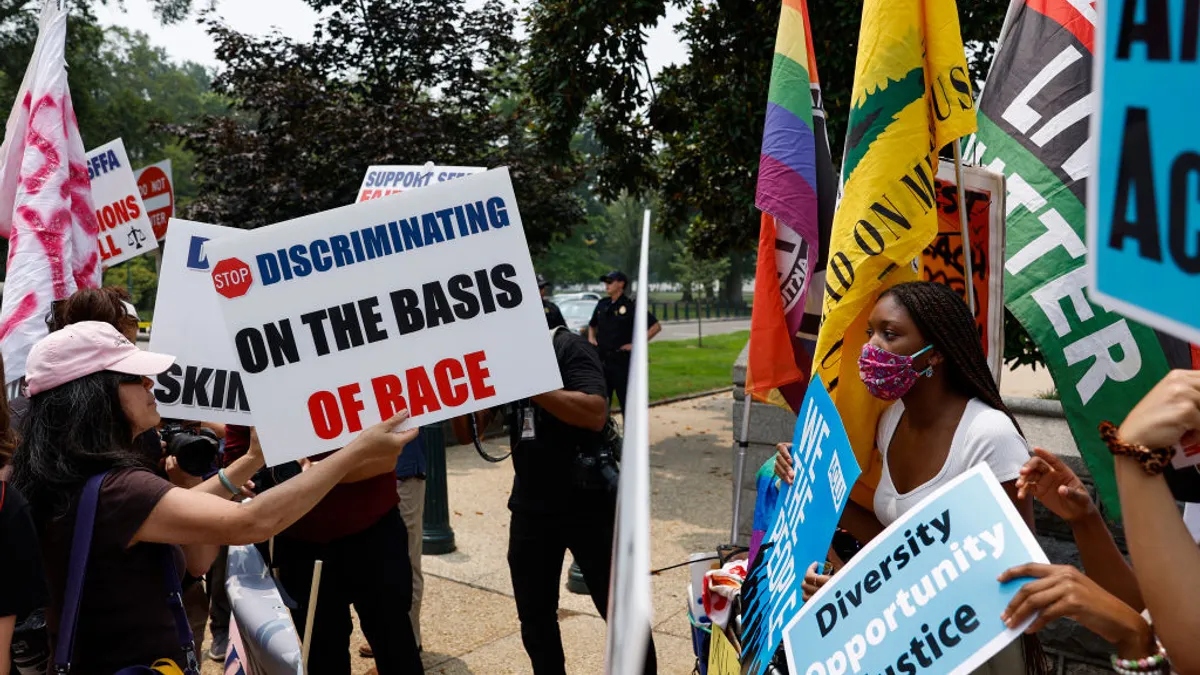A strong, visible corporate culture helps business grow and keep market share. The companies you want to buy from – and work for – have a brand identity that garners consumer loyalty, attracts top talent and engages and retains employees.
Corporate culture clearly has value. An Employee Engagement and Organizational Culture Report found that turnover at companies with a poor work culture drastically outpaced turnover at those with strong culture, 48% to 14%.
For many recruiters and hiring managers, however, “culture fit” has become less about the overall corporate culture, and more about the culture of a team or workgroup. It’s become a subjective catch-all phrase for some to exclude people in the workplace.
Fit to exclude
The “wasn’t a fit” excuse allows for little recourse or discussion. When culture fit becomes about people you work alongside, rather than how someone fits within the organization overall, the potential for abuse is limitless. The idea that culture fit means people “like us” is where things have taken a wrong turn.
Suddenly, diversity takes a hit, creating echo-chamber workforces that struggle to innovate. It also may violate federal law if an employee "doesn't fit" because of a protected characteristic, like age or religion. A culture fit must mean new hires share the same goals and values as the organization, not the background and views of a select team.
Exclusionary practices
The term “culture fit” should be limited to the likelihood that a particular candidate will be able to conform and adapt to the internal values and ideological structure of the organization, says Debra Ellwood Meppen, partner at Gordon & Rees. "Unfortunately it is too often the case where the term culture fit is used to support an improper or discriminatory motivation aimed at prejudicing those in a, or several, protected classes. When this is the purpose of the term, both the intent and the impact are illegal.”
Meppen offered some tips on avoiding this trap. Employers should clearly set forth their goals, expectations, core values and attitudes in advance of the hiring process, she said. "The definition of 'cultural fit' should be neutral, narrowly tailored and tied to specific company and/or firm goals, financials and items that can be unique to the organization, but legal and cognizable as a goal that anyone can meet regardless of their falling within any protected categories.”
Smart companies look for new team members that enhance the group dynamic, rather than create a homogenous team. Using “culture fit” as a means to exclude is an outdated corruption of what can be a valuable hiring tool.
Michael Scott or Gordon Gekko?
The challenge is to reclaim the term culture fit as the organizational culture, rather than the culture in teams and groups. Once the organizational culture is defined, it can trickle down to hiring strategies and beyond. Whether a candidate looks like "us" or has a similar background must be immaterial; hiring managers can ask themselves, "do they meet the needs of the organization’s culture?"
Few Type A personalities would fit the culture of Dunder Mifflin, with Dwight Schrute as the glaring example of a non-culture fit. The laid-back Michael Scott led a non-competitive workplace. It’s doubtful the remaining staff of The Office would have succeeded under the management of a Gordon Gekko Wall Street-type. Whether large companies identify their overall culture, or smaller branches identify their regional culture, the values and attributes identified have little to do with physical or experiential qualities, and more to do with beliefs, work ethic, and motivational levels.
Aligning values
Mila Singh, culture strategist at CultureIQ, believes that, in short, culture fit is value alignment. "This means that an employee’s values, beliefs and behaviors are aligned with their employer's core values," she said.
Companies can ensure culture fit by incorporating their values right into the interview process. "For example, they can ask prospectives about a time when they exemplified a value,” Singh suggests.
She also recommends that hiring managers and anyone involved in hiring decisions go through unconscious bias training. Then, “recruit from a variety of sources so you find candidates from a variety of backgrounds," she said. "Structure your interview process so a diverse group of interviewers can select and meet with candidates.”
“Not a good fit” is not good enough
Once a company or workgroup has identified its corporate culture, hiring for fit can be done without exclusion. To do so, hiring managers and recruiters can target culture specifically with questions like "What type of work environment do you thrive in?" or "How would you describe your work style or ethic?"
If you have a collaborative work team that bounces ideas off each other routinely, a candidate that categorizes themselves as a lone wolf might not be a good fit. Alternately, a group of independent workers would not mesh well with someone who identifies themselves one who needs a team effort to perform.
It happens to the big guys, too
At Facebook, the use of the term “culture fit” is prohibited when providing candidate feedback. Interviewers are pushed to provide more specifics. The belief that the term and its use can be fraught with unconscious bias led them to shift their assessment to find how candidates align with their core business values. Interviewers have to point to specific responses that underscore any discrepancy. If they can't, they’re asked to re-interview the candidate.
Sumayyah Emeh-Edu, a diversity and talent management consultant, admits, “I have used the term "culture fit" while interviewing candidates. What I thought I was sourcing for was like-minded people who could "survive" in our fast-paced and highly regulated industry."
"I considered myself practicing meritocracy," she said. "But what I now realize is that my past experiences [were] causing me to make assumptions, so I would therefore tailor the questions to the candidates based on this, many times casting doubt on them."
"We all want a magic formula for predicting talent," Emeh-Edu said, "education, prior experiences, who they know." But by using researched-based principles, organizations have the opportunity to hide non-essential factors (school, name, affiliations) from resumes to reduce biases, she said. They can implement uniform hiring processes, define culture and train managers on inclusive interview techniques. "They should also track individual manager compliance on meeting hiring/inclusion goals," Emeh-Edu added.
So "challenge the ‘fit excuse," Meppen recommends, and limit how much “fit” can sway hiring decisions. If a candidate is eliminated for fit reasons, hiring managers should be able to explain and quantify this decision based on neutral, non-discriminatory criteria. "Stop accepting vague explanations of 'a bad culture fit,' especially when the impact could exclude or reject diverse candidates from consideration," she said.





















